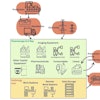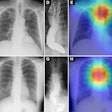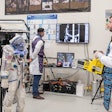Dear AuntMinnie Member,
U.S. and Japanese researchers say they have overcome a barrier to clinical implementation of dynamic digital radiography.
In a recent study, the group showed for the first time that automated software they developed allows them to capture lung signal changes in patients with chronic obstructive pulmonary disease during forced breathing tests. Click here for the story.
In other news, thoracic surgeons at the University of Toronto in Ontario, Canada, reported that ordering x-rays after removing chest tubes from lung surgery patients may be unnecessary after finding no more adverse events based on clinical observation alone.
We also reported on several digital x-ray AI studies that tested commercially available products. In one, a group in Korea recently validated a deep-learning model called CXR-Age that estimates biological age from chest x-rays in a large cohort of Asian individuals; in another, researchers found that RBknee version 2.1 improved the performance of junior radiologists when grading knee osteoarthritis.
In another AI study, researchers developed an algorithm that identifies osteoporosis on chest x-rays and that could help screen for patients at high risk for the disease.
Speaking of osteoporosis, we noted a study suggesting that assessing bone mineral density on the sides of the jaw via panoramic dental x-rays could also help flag patients at risk for the disease.
Nonetheless, dual-energy x-ray absorptiometry (DEXA) remains the gold standard for assessing bone health, as was clear in research we covered in the following stories:
- In obese patients undergoing bariatric surgery, DEXA revealed a higher prevalence of osteoporosis and low bone mass two years after the procedure, according to a study in Bone Reports.
- U.S. researchers found that a majority of participants with high body mass index (BMIs) also had high body fat measurements on DEXA – a finding that indicates BMI remains a good screening tool for identifying children with high adiposity.
- DEXA suggests that people with schizophrenia have lower bone mineral density and higher rates of fracture than individuals without the condition, according to a team in Australia.
Finally, we highlighted a study also conducted by Australian researchers who say they have invented a technique using x-rays and 3D surface body scans that could optimize body armor for soldiers.
That’s all for now. Be sure to check in regularly with our Digital X-Ray Community for more news.



















